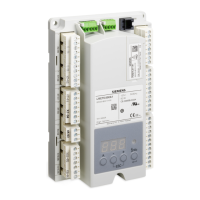LME Series Technical Instructions
Document No. LME-1000
SCC Inc. Page 3 Section 9
Connecting to a PC
The following steps summarize the procedure for establishing communication between the
LME7 and a PC.
1. An OCI410 interface module is required to connect the LME7 to a PC. Three different
interface modules are available:
Table 9-1: Available Interface Modules to Connect the LME7 to a PC
Interface Module Capabilities
OCI410.20
User level PC interface module. Permits access to user level parameters
only without the ability to perform parameter backups
OCI410.30
Service level PC interface module. Permits access to user and service
level parameters and the ability to perform parameter backups
OCI410.40
OEM level PC interface module. Permits access to all parameters and
the ability to perform parameter backups
It is highly recommended to acquire at least the OCI410.30 interface module.
2. Once the interface module is acquired, the LME7 can be connected to the PC. If an AZL23 is
being used, unplug the AZL23 from the LME7. Connect the RJ11 plug of the OCI410 interface
module into the X56 port on the LME7. Connect the USB plug of the OCI410 interface module
into a USB port on the PC. The ACS410 software should automatically identify which COM port
the OCI410 interface module is plugged into.
3. Open the ACS410 software. Click “OK” on the safety note and the “Login” dialog box will
appear. Click the “Online” button, and then select which password level is desired (IS – user,
SO – service, OEM – OEM). If attempting to connect at the service or OEM level, enter the
password. Remember that the OCI410.30 module is required to access the service level, and
the OCI410.40 module is required to access the OEM level. Then click “Connect”.
Note: The password is case-sensitive, and only certain characters are allowed to be typed into
the password field. For this reason, it is much easier to click the “#” button next to the
password and click on each character instead of typing the password manually.

